Tracy Hilton here from Food and Meal, excited to share with you one of my favorite Japanese condiments – the vibrant Beni Shoga pickled ginger!
I first discovered beni shoga years ago when visiting my aunt in Tokyo. We would go out for sushi and ramen, and every meal was served with a small pile of shocking pink pickled ginger. I loved the way its bright color and zippy, tangy flavor contrasted the rich, fatty cuts of fish and brothy noodle soups. It was the perfect palate cleanser between bites.
When I returned home, I tried to satisfy my cravings by buying those plastic containers of sushi ginger from the grocery store. But the flavor just wasn’t the same! So I asked my aunt for her recipe and tips on making beni shoga from scratch.
Now, homemade beni shoga has become one of my favorite condiments to always have on hand. I use it to accent all kinds of Asian-inspired dishes from stir fries to poke bowls. That pop of color and pickled tang elevates everything. I also love nibbling on beni shoga straight from the jar as a zesty snack!
Making your own only takes about 30 minutes of active prep time. You’ll julienne fresh ginger root, massage it with salt to pull out moisture, then quickly pickle it in a sweet vinegar mixture tinted pink with red shiso leaves or natural coloring. The end result is so much more vibrant and flavorful than store-bought.
Beni Shoga recipes
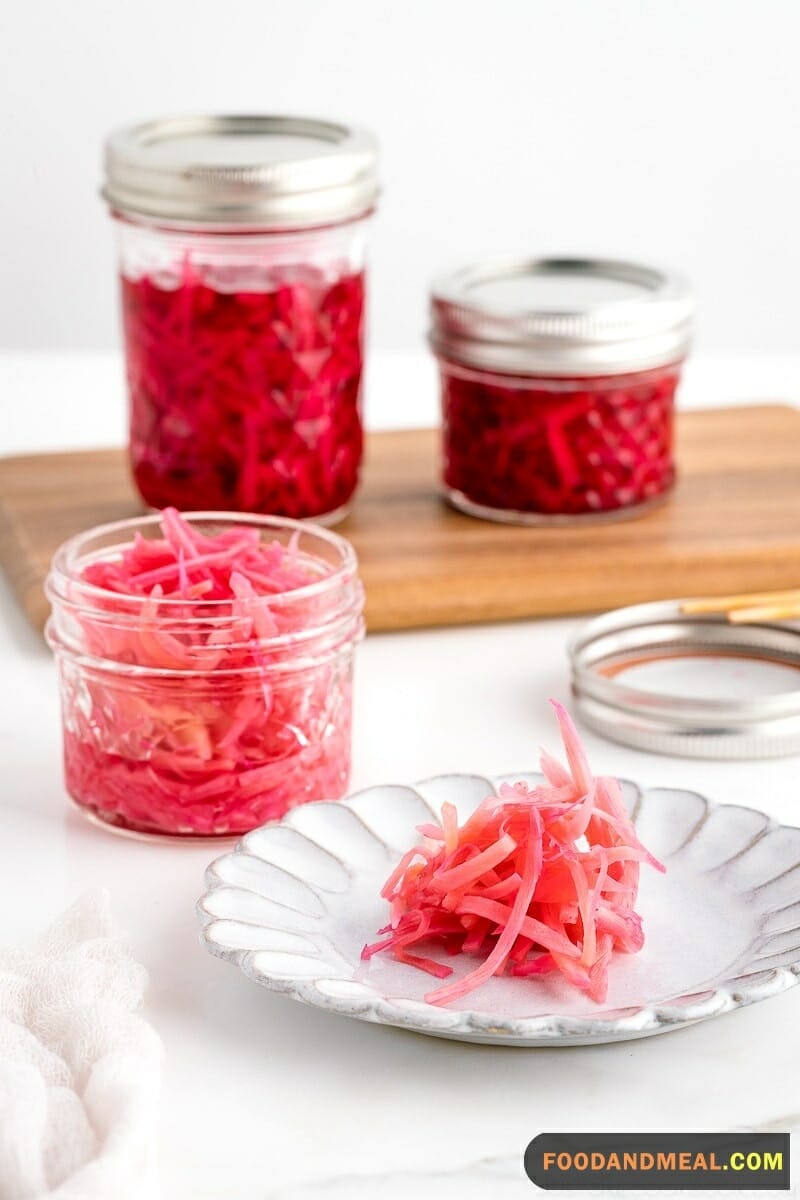

Beni Shoga - Red Pickled Ginger
Equipment
Ingredients
- 1 cup umezu or umeboshi vinegar
- 2 tablespoons kosher salt
- 2 tablespoons sugar
- ¼ cup mirin
- ½ pound ginger fresh, peeled and cut into 2-inch-long matchstick pieces
Instructions
- In a glass bowl or jar, combine the umezu or umeboshi vinegar, salt, sugar, and mirin. Add the ginger, cover, and refrigerate for at least 2 weeks.
- Beni shoga will keep in a covered jar in the refrigerator indefinitely.
Video
Notes
Nutrition
© Food And Meal
This website provides approximate nutrition information for convenience and as a courtesy only. Nutrition data is gathered primarily from the Spoonacular Database, whenever available, or otherwise other online calculators.
Alternative Method: Preparing Beni Shoga Using a Food Processor
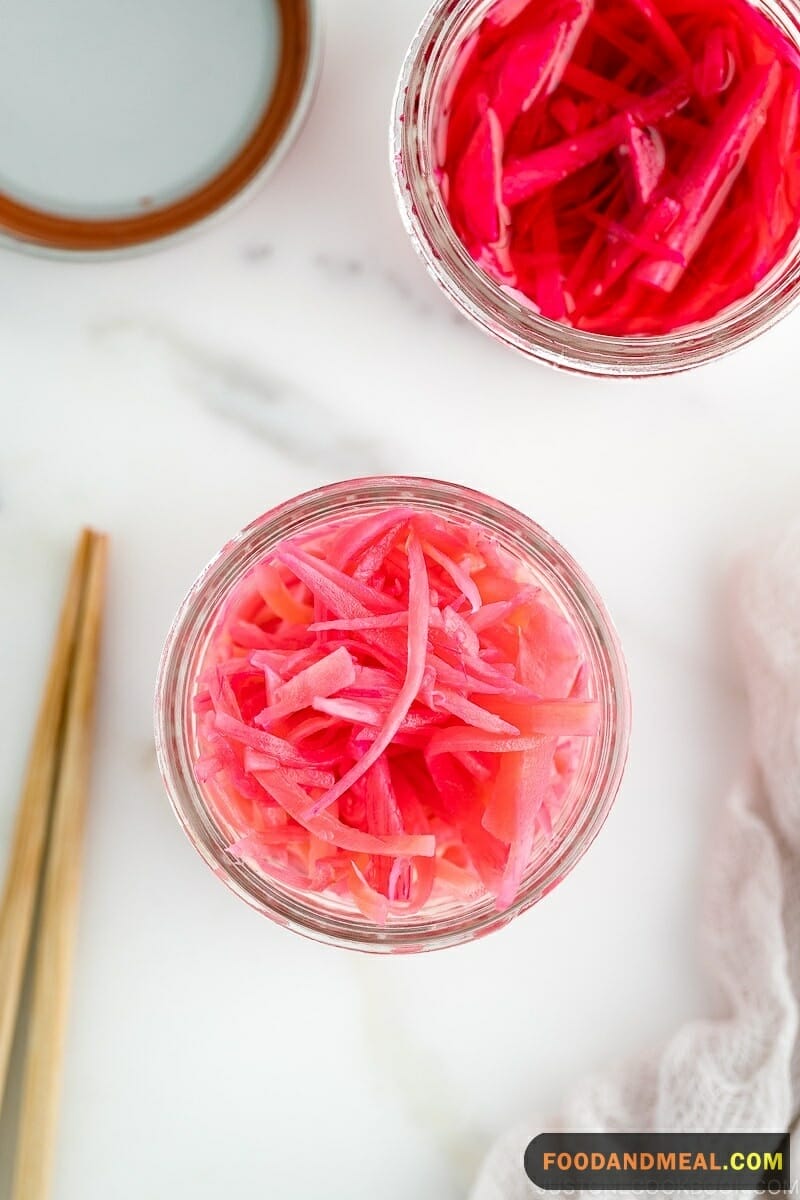
After meticulously peeling and slicing the young ginger, the next step in preparing homemade Beni Shoga involves salting the ginger slices. This process entails placing the thinly sliced ginger in a bowl and generously sprinkling it with kosher salt, ensuring uniform coating for each piece. Allowing the ginger to rest for approximately 30 minutes permits the salt to draw out excess moisture, consequently tempering the ginger’s inherent spiciness. Following this, the salted ginger undergoes a thorough rinse under cold running water to rid it of any lingering saltiness, after which it is carefully drained and patted dry with paper towels. Subsequently, the ginger slices are finely shredded in a food processor, producing uniformly textured strands. Meanwhile, a delicate brine is concocted by gently heating rice vinegar and sugar until the sugar dissolves, yielding a subtly sweet and tangy infusion. Once cooled, the brine is combined with the shredded ginger in a clean glass jar, ensuring complete submersion of the ginger in the aromatic liquid. Finally, the jar is tightly sealed and refrigerated, allowing the flavors to harmonize and intensify over a minimum period of 24 hours. This homemade Beni Shoga serves as a delectable accompaniment to various Japanese dishes, such as sushi and sashimi, with its vibrant flavor profile enhancing every culinary endeavor. Any surplus can be conveniently stored in the refrigerator for prolonged enjoyment, showcasing the versatility and longevity of this traditional Japanese condiment.
Tips for making Beni Shoga
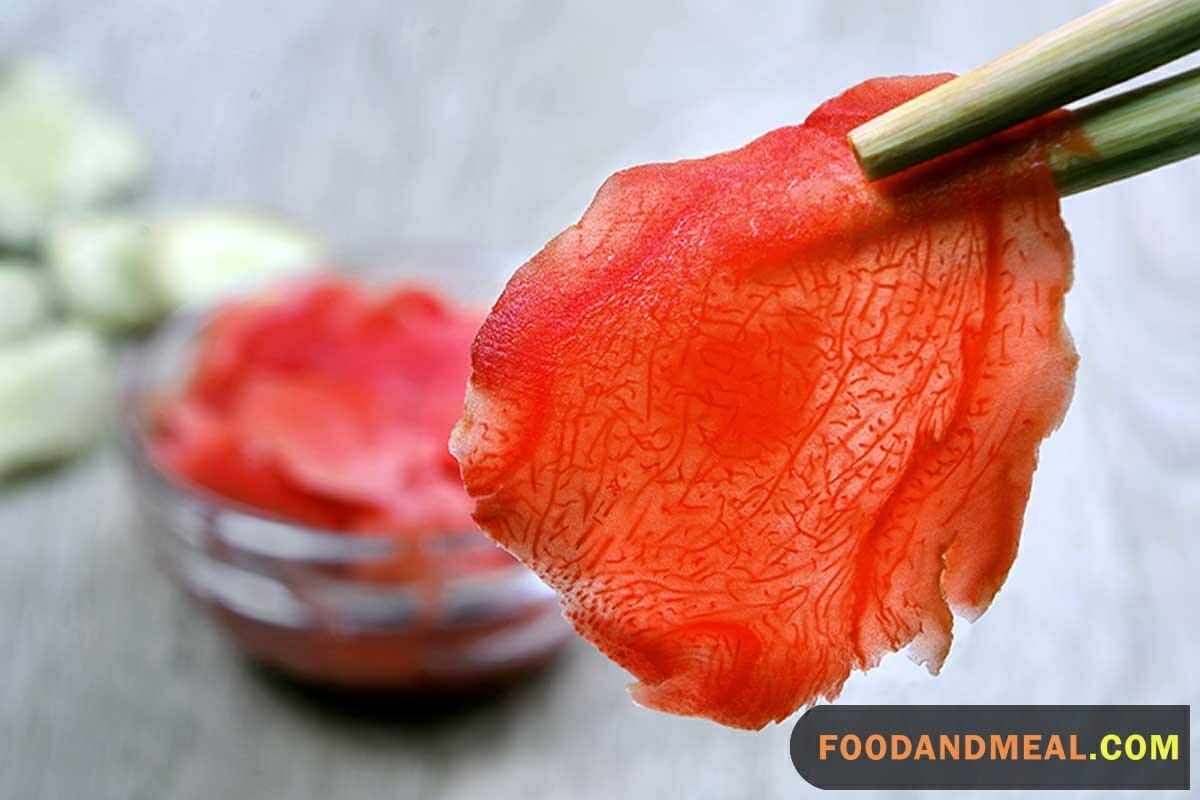
Cooking Tips
The key to crisp, flavorful beni shoga is starting with very fresh, firm ginger. Choose smooth, unblemished roots and peel thoroughly before slicing paper-thin. Take your time with this step! I actually find the repetitive slicing motions quite soothing. Just be sure to protect your fingers.
Now comes the fun part – massaging the ginger slivers with salt to soften them before pickling. I mix in a bit of sugar too for subtle sweetness to balance the vinegar. Then it all gets to soak in that hot pink vinegar bath! I like using red shiso leaves or natural coloring for that signature blushing hue.
As the beni shoga pickles, the aroma is out of this world – fresh, zingy ginger mingling with rice vinegar and a hint of sweetness. I try to be patient and let mine pickle for at least a few hours before sampling, but it’s hard to resist!
Serving Suggestions
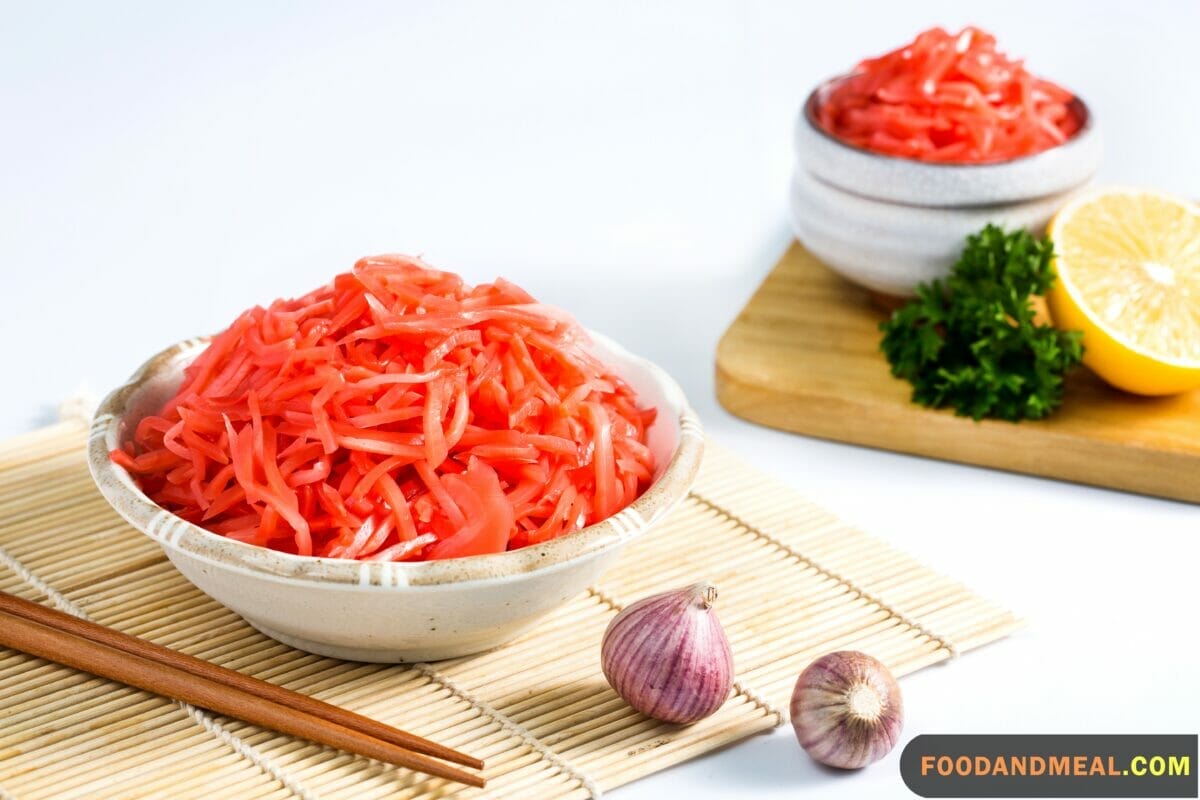
Beni Shoga, with its vibrant flavor and tangy kick, pairs exquisitely with a variety of dishes, enhancing their taste profiles and adding a delightful crunch. For a traditional Japanese meal, serve it alongside Yakimiso Ramen or Tonkotsu Ramen, allowing its zesty notes to complement the rich broth and tender noodles. It also makes a perfect accompaniment to Teriyaki Salmon, adding a refreshing contrast to the savory fish. For those craving a taste of the sea, serve it with Shrimp Tempura, where its acidity balances the crispy texture of the tempura. Additionally, Beni Shoga brings a burst of flavor to Vegetable Maki, enhancing the sushi rolls with its unique tanginess. Whether enjoyed with ramen, seafood, or sushi, Beni Shoga adds a touch of authenticity and zest to every dish, making it a versatile and indispensable condiment in Japanese cuisine.
Frequently Asked Questions about Beni Shoga
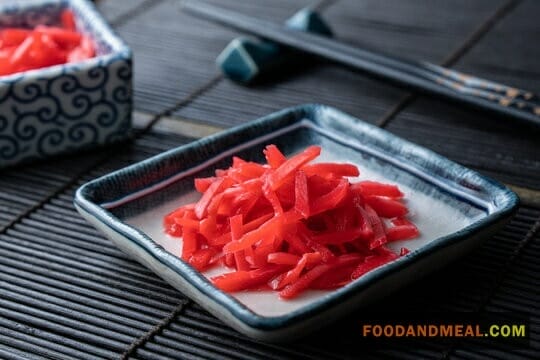
- How long does homemade Beni Shoga last?When stored in an airtight container in the refrigerator, homemade Beni Shoga can last for several months. It continues to develop flavor over time.
- Can I use regular ginger instead of young ginger? While young ginger is preferred for its milder taste, you can use regular ginger if you can’t find the young variety. Just be aware that it will have a spicier kick.
- Is food coloring necessary for the recipe? Food coloring is optional and primarily used to achieve the traditional red or pink hue of Beni Shoga. You can skip it if you prefer a more natural look.
- Can I adjust the sweetness and acidity of Beni Shoga? Absolutely! Feel free to adjust the sugar and vinegar ratios to suit your taste preferences. Some like it sweeter, while others prefer it more tangy.
- What dishes can I enhance with Beni Shoga? Beni Shoga pairs well with sushi, sashimi, ramen, noodles, burgers, sandwiches, curry, rice, salads, and even drinks. Its versatility makes it a fantastic addition to various cuisines.
Conclusion
In conclusion, incorporating homemade Beni Shoga into your culinary repertoire opens up a world of flavor possibilities, elevating your dishes with its unique taste and texture. Whether enjoyed with comforting ramen, delicate seafood, or flavorful sushi, this tangy condiment adds depth and complexity to every bite. With its easy-to-follow recipe and versatile serving suggestions, you can effortlessly enhance your meals with the vibrant taste of Beni Shoga. For more delicious recipes and culinary inspiration, visit Food And Meal at foodandmeal.com. Discover the joy of homemade condiments and elevate your cooking to new heights with Beni Shoga.
I'm Tracy F Hilton, a devoted culinary professional shaped by a mix of natural aptitude and refined skills from a top culinary school. In the dynamic kitchen environment, I'm a catalyst for seamless operations and timely, high-quality dish preparation. My culinary creations are a blend of art and skill, offering visually and gustatorily delightful experiences. A learner at heart, I'm continuously honing my craft, embracing new techniques, and culinary innovations. My positive, collaborative nature is amplified in fast-paced settings, showcasing my commitment to team efficiency and guest satisfaction. Each dish I present is a meticulous blend of tradition and innovation, promising an unforgettable dining experience that marries taste, aroma, and aesthetic appeal in perfect harmony. Join me on a gastronomic journey where each bite encapsulates a rich, evolving narrative of flavors and culinary artistry.


